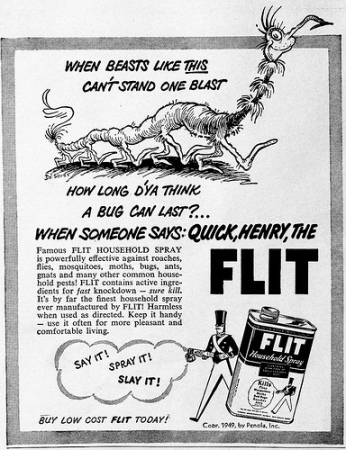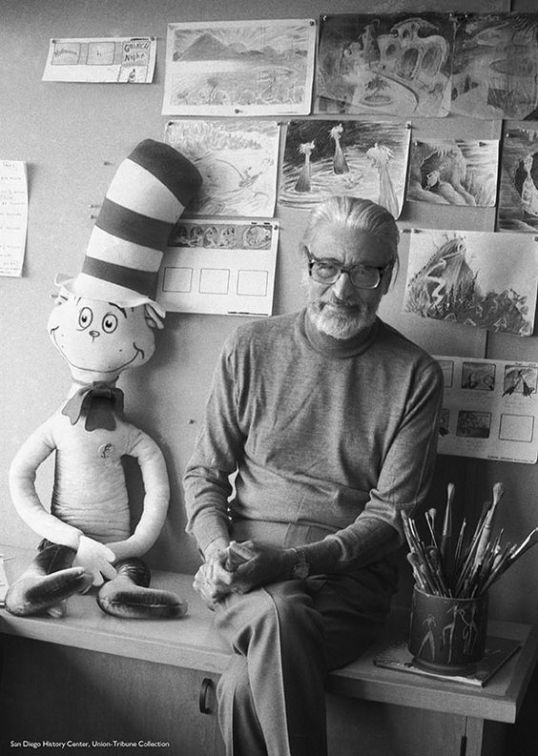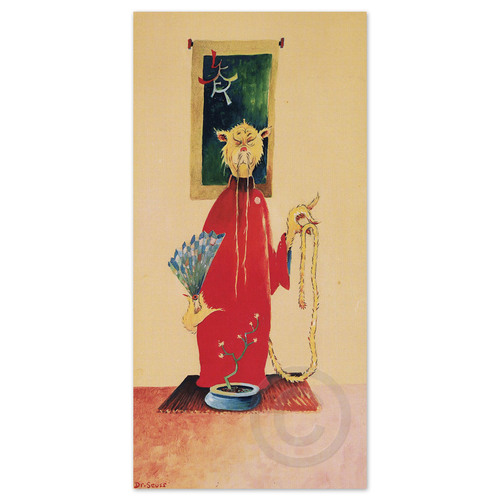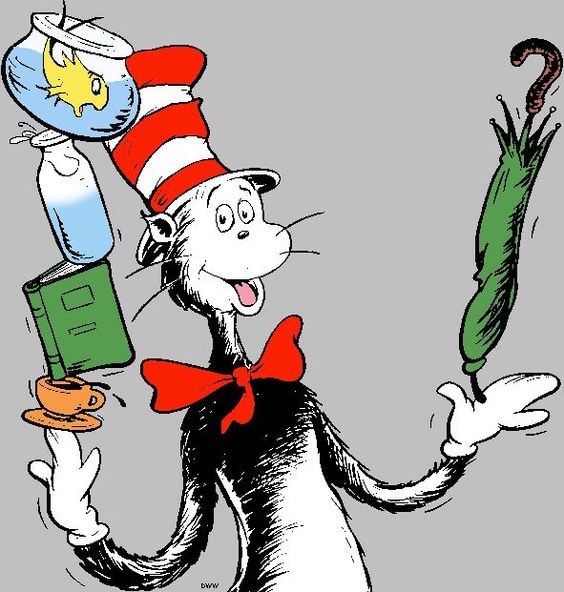You have brains in your head. You have feet in your shoes. You can steer yourself in any direction you choose. You’re on your own, and you know what you know. And you are the guy who’ll decide where to go.~Dr. Seuss
Many of us think we know Dr. Seuss, whose children’s books sold 600 million copies and were translated into more than 20 languages by the time of his death in 1991.[1]
We have read and re-read his classics like Cat in the Hat and watched his films like The Grinch Who Stole Christmas. For many of us, Dr. Seuss’s books were the first we read on our own. For other children, like my son who struggled with reading, Dr. Seuss was a breath of fresh air. His books created imaginary worlds with characters and rhymes that were quirky and captivating and made him laugh. Most importantly, they made reading fun. Over time, the rhymes were imprinted in my son’s mind like secret codes that unlocked the mystery of written language.
That in itself is a tremendous achievement. But in fact, Dr. Seuss’s work went far beyond that. As I researched his work and his life, I was astounded to learn that his far-ranging talents and accomplishments extended to graphic and fine art, political satire, children’s literacy, and environmental issues.
Childhood
Why fit in when you were born to stand out?~Dr. Seuss

Dr. Seuss (Ted Geisel) and one of his dogs. Source: Pinterest
Born and raised in Springfield, Massachusetts, young Theodore (Ted) Seuss Geisel was greatly influenced by his parents–Henrietta Seuss and Theodore Robert whose family roots were in Bavaria. The family thrived in Massachusetts and ran prosperous distillery until Prohibition.
After closing the business and enduring unemployment, Ted’s father became the superintendent for the Springfield Park System. Young Ted often visited the Springfield Zoo with his father and brought along his sketchpad. It’s easy to see how his early sketches of animals sparked his imagination and were transformed in his later illustrations. He also credits his mother for his interest in rhymes, since she often chanted to Ted and his sister Marnie when they had trouble falling asleep.
Education and Early Career

Flit ad by Dr. Seuss
After graduating from Springfield High School, Ted studied at Dartmouth, majoring in literature. While at Dartmouth, he submitted cartoons to the college’s humor magazine, Jack-O-Lantern. When Ted and several friends were caught drinking in a dorm, a direct violation of Prohibition rules, Ted was ordered by the dean to stop working for the magazine. The wily Ted found a loophole and submitted cartoons with various pseudonyms, such as Seuss, L. Pasteur, D.G. Rossetti ’25, and T. Seuss. With the encouragement of a professor of rhetoric, W. Benfield Pressey, Ted also started writing more seriously. After graduating from Dartmouth, he enrolled at Oxford College in London, intending to earn a PhD in English literature, but he changed his plans after meeting Helen Palmer, who looked at his notebooks filled with doodles and sketches and encouraged him to pursue a career in drawing.
After Ted and Helen married, they moved to New York City, where Ted worked freelance as an illustrator, selling his work to Life Magazine and Vanity Fair. A cartoon published in July, 1927 in The Saturday Evening Post, help him land a staff position at Judge, a New York weekly. He worked in the advertising department for the next 15 years, creating ads for Holly Sugar, NBC, Ford, and General Electric among others. But his ad for Flit, a common insecticide, became nationally famous. “Quick Henry, the Flit” became a part of the American vernacular as a standard line to use in emergencies.
World War II
Unless someone like you cares a whole awful lot, nothing is going to get better. It’s not.~Dr. Seuss

The politically-aware Ted Geisel observed what was happening overseas as fascism spread across Europe. He started drawing political cartoons to bring to public awareness the growing menace of dictators Benito Mussolini, Adolf Hitler, and Emperor Tojo. During the war, he became a weekly contributor to PM, a newspaper financed by the Chicago millionaire Marshall Field. More than 400 of his cartoons were published there, as well as those of other political satirists, such as Crockett Johnson, creator of the comic strip Barnaby.
When America entered the war, Geisel was already in his mid-30’s, beyond the age of the draft, so he enlisted in Frank Capra’s Signal Corps, creating animated training films and documentaries. He also drew propaganda posters for the Treasury Department and War Production Board.
Children’s Book Author
Adults are obsolete children.~Dr. Seuss
It’s not clear whether Ted started writing children’s books when he learned that he and his wife Helen could not have children. He did however send Christmas cards to friends, signing the names of fictional children, such as Chrysanthemum-Pearl, Wally, Miggles, Boo-Boo, and Thnud.²

Ted Geisel. Source: Pinterest
Like many writers, the “road” to publication was not easy. His first children’s book was never published since no publisher wanted his ABC book filled with a long-necked whizzleworp and a green-striped cholmondelet. He tried again several years later with a second children’s book– And to Think I Saw It on Mulberry Street, which was rejected by dozens of publishers. Ted Geisel described what happened next as a stroke of luck. After the last rejection, he was ready to throw the book away. But as he was walking down Madison Avenue, he ran into a Dartmouth classmate, Mike McClintock, who was just appointed editor of the juvenile department at Vangard Press. Geisel was quoted as saying, “That’s one of the reasons I believe in luck. If I’d been going down the other side of Madison Avenue, I would be in the dry cleaning business today!”³
Another turning point in his writing career was in 1954 when Life Magazine published an article critical of children’s literacy in the United States. The publishing companies Houghton Mifflin and Random House asked him to write a basic reading book for children using 220 vocabulary words. Geisel’s creation replaced the boring and predictable children’s primer Dick and Jane with a fun-loving cat. His book, The Cat in the Hat, published in 1957, became a “tour de force”–as described by one critic–and thrust Geisel into the limelight of children’s literature. (4)
In response to another challenge by Random House publisher Bennett Cerf who dared him to create a book using only 50 words, Geisel wrote Green Eggs and Ham with the iconic character Sam I Am. By using the philosophy of phonetic learning to teach reading and a cadence (anapestic tetrameter) that was easy for children to understand, Geisel became an influential force in children’s literacy. Using this model, Ted and his wife Helen with Bennett Cerf and his wife Phyllis started Beginner Books at Random House.
Humanitarian, Activist, and Artistic Legacy
A person is a person no matter how small–Dr. Seuss
Reading his books as an adult, I have realized how many of them focused on social and political issues: The Lorax (1971) about the environment and anti-consumerism; The Sneetches (1961) about racial equality; Yertle the Turtle (1958) about the danger of Hitler; Horton Hears a Who (1954) about anti-isolationism and internationalism.(5)
Public recognition and accolades continued throughout Geisel’s lifetime, including 3 Caldecott Awards for his children’s books, an honorary doctorate from Dartmouth, and an Academy Award for the Best Documentary Feature in 1947 for Design for Death, written by Ted and wife Helen. In 1984 he received a Pulitzer Prize “for his contribution over nearly half a century to the education and enjoyment of America’s children and their parents.” He is also the only book author to be included in the book 100 People Who Changed the World, published by Life Books in 2010.
Geisel’s artistic output was immense: 44 children’s books, more than 400 political cartoons, and hundreds of advertisements. If that weren’t enough, for over seven decades he worked as a surrealist, creating fine art which is uniquely true to his creative vision.

Orient Cat by Ted Geisel
I know that future generations of children will learn to read with his books and start to love reading because of them. Parents like me, who struggled to unlock the mystery of reading with their children, appreciate the humor and creativity of Dr. Seuss who transformed reading from a chore to something fun. His humor, creative vision, and artistic style are gifts to all of us. They are unique and enduring.
To learn more about Dr. Seuss and his work, click on the links below:
This is the thirteenth in a series of articles about forward thinkers who are helping to solve some of the world’s greatest challenges. These remarkable people are helping to define the future direction of their community, country, and even our global society. To read more about the Pilot Fish Trailblazer Awards and the nominees Dr. Fred Sanger, Paolo Soleri, Ruth Bader Ginsburg, Jane Goodall, Alice Waters, Swami Vivekananda, The Man in Black, Dr. B. R. Ambedkar, Dr. Jean Raffa, Astrid Lindgren, Sadar Vallabhbhai Patel, and Cleveland Amory, click on the embedded links. Suggest new nominees in the comments section below.
Categories: Pilot Fish Trailblazer Awards

I’ve always loved Dr. Seuss. I read his books as a child and read them with my own children.
LikeLiked by 1 person
I did too, Karen. I had no idea he was so prolific in so many types of art. Did you?
LikeLike
I taught children’s literature to college students for years. There was a gorgeous children’s book store not too far away. The owner refused to carry any Dr. Seuss books. Her rationale was that they weren’t literature. I’ve spent 20 years trying to figure out why she thought they weren’t literature. Maybe she thought they filled up such a large space in the culture that there wasn’t enough room left for all the rest of children’s literature!
LikeLiked by 1 person
Hi Luanne. What an amazingly stubborn book owner! It’s almost comical how she “took a literary stand” against Dr.Seuss. Then again, the same thing has happened to other popular writers like Stephen King, whose work has endured. Who can figure it out? That sounds like a great class that you taught!
LikeLiked by 1 person
Yes, it has happened to Stephen King. It’s mystifying to me when people are so sure of themselves haha. The class was wonderful fun. One assignment was to go to a children’s book store or children’s section in a book store and write up an evaluation of the books. That way students could get their hands on a lot of children’s books without having to buy them ;). As it is, they had to buy plenty for “textbooks.”
LikeLiked by 1 person
Great idea!
LikeLiked by 1 person
He is quite the character… His books are marvellous
LikeLiked by 1 person
So glad you know his books. They are marvelous. You’re right. He is quite a “character” –just like the ones he created!
LikeLike
He is… And, I still have to complete the Kurien essay!
LikeLiked by 1 person
No worries! You always get it done somehow!
LikeLike
I will… ‘Cept that I am going through a brain freeze these days… I deleted 925 Gb of data / photos.
Luckily I had a back up.
And, we have to rearrange some items at home. Some vastu stuff
LikeLiked by 1 person
Luckily you had a back up! You must have had a few moments of panic before you found it. Good luck on the re-arranging. I don’t envy you!
LikeLike
What a great read. I found this fascinating. Loved the pictures and the quotes. ( must try to remember them) but mostly thank YOU for the super read.
LikeLiked by 1 person
Hi LB! Thanks so much! You’ve made my day. He is a fascinating character, isn’t he? I stumbled upon his political cartoons when I was researching my next novel. I had to write about him!
LikeLike
Yes – such a fascinating character. You must keep me in the loop re your new novel. Clever you!
LikeLiked by 1 person
Why thank you! I will definitely let you know how it’s progressing and when it’s ready to read. 🙂
LikeLike
Dr. Seuss filled the bookshelves for millions of children. He made it fun to learn to read. I really appreciated this peek into his life story, Patti. I had no idea he struggled to get his first book published.
Great post!
LikeLiked by 1 person
So glad you enjoyed this, Jackie! I was so surprised that his work was so wide-ranging.
LikeLike
I grew up with him, what an interesting article, and how humanitarian he was!
LikeLiked by 1 person
So glad you enjoyed this one, Maria. He was a very interesting artist and so multi-talented.
LikeLike
Interesting, as usual. This man I knew nothing of – though I know about the Grinch through the movies. And yet I have studied several years at university – children’s literature! This shows, again, the importance of your mission with letting us have a look into maybe unknown treasures through your Trailblazer series!
LikeLike
Hi Ann-Christine. I’m so glad that this article was interesting to you. I was fascinated to learn how diversified an artist he was. Thanks again for joining the conversation!
LikeLike
Interesting eclectic life. I love Horton!!
LikeLiked by 1 person
Hi Cybele. So glad you liked the article and Horton! Thanks for joining the conversation.
LikeLiked by 1 person
I still have some of his books. They are high art.
LikeLike
They are, Dunelight. Thanks so much for joining the conversation!
LikeLiked by 1 person
I was such a rigid thinker, as a child. Dr. Seuss books terrified me because of the invention of non-real words and the scary make-believe animals. (I think I was scared by one cover as a toddler and I just cut poor Dr. Seuss out of my life for good.) Then, I had a child of my own, and discovered the delight of reading the sing-song syllables and making up voices. It took me thirty years, but I finally fell in love with the Dr. Seuss. Now I know a little more behind how he became a maker of childish worlds, I’m even more impressed.
LikeLiked by 1 person
Wonderful insight into his works! I agree that it’s delightful to read these books aloud as a parent. I loved reading them to my son.
LikeLiked by 1 person